Bike racing is nothing without drama. I love scrappy breakaways, daring long-range attacks, chaotic high-speed sprints, heart-breaking crashes, and heated rivalries. It’s all part of what makes the Tour de France the most amazing spectacle in sport.
But it wasn’t drama that first drew me to bike racing. It was the machines. My passion for bike racing grew out of an impulse to drool over road bikes and to watch them go as fast as possible.
Cycling is special because anyone can purchase the same bikes and equipment used by pro riders. I’ve had the pleasure of buying, photographing, and selling many of the same top-of-the-line models that were ridden in the Tour. Every time I see one of these bikes, I like to think back to all the Tour de France moments that it was part of.
You may remember the great moments of the Tour. You may remember the riders. But do you remember the bikes? These my seven most memorable Tour de France moments of the previous decade, with a closer look at the bikes that propelled them:
1. Chain-gate - Specialized S-Works Tarmac SL3
2. The underdog from Down Under - BMC Teammachine SLR01
3. The rise of the Sky bots - Pinarello Dogma 65.1 Think2
4. The Tourminator - Cannondale SuperSix Evo Hi-Mod
5. Froome's footrace - Pinarello Dogma F8
6. Dutch duel - Scott Foil RC
7. 'Cross-over success - Bianchi Oltre XR4
Vintage bonus: Eight seconds - Bottecchia TT
1. Chain-gate
Contador attacks Schleck after a mechanical - 2010
There are lots of unspoken rules in professional cycling that revolve around sportsmanship and tradition. Alberto Contador broke one of these rules on stage 15 when he attacked Andy Schleck after a mechanical on the Port de Balès. Schleck initiated an attack before the summit but moments later he came to a screeching halt with a dropped chain. As Schleck desperately tried to fix his bike at the side of the road, Contador flew past.
Should Contador have waited for Schleck until his bike was fixed? Would Schleck have waited if the roles were reversed? Chain-gate, as it became known, was the most talked-about racing incident of the year. After some fumbling, Schleck was able to replace his chain and put in a powerful surge, but he lost 39 seconds and the yellow jersey to Contador.
The bike: 2010 Specialized S-Works Tarmac SL3
 In this iconic moment, the Specialized S-Works Tarmac was the bike of both the villain and the victim. A case of fratricide? Well, in racing it doesn’t matter what the other rider’s on — you’re out to win. The S-Works Tarmac was made to do just that. Specialized revamped its entire road bike range for the 2010 model year, and the S-Works Tarmac was the lightest, most race-focused option.
In this iconic moment, the Specialized S-Works Tarmac was the bike of both the villain and the victim. A case of fratricide? Well, in racing it doesn’t matter what the other rider’s on — you’re out to win. The S-Works Tarmac was made to do just that. Specialized revamped its entire road bike range for the 2010 model year, and the S-Works Tarmac was the lightest, most race-focused option.
The S-Works Tarmac SL3 “module” (frame, fork, headset, crankset, seatpost) weighed 2,047 grams, shaving an impressive 153 grams off of the already light Tarmac SL2 module. Full builds were capable of getting into the 13-pound range. Despite the weight loss, Specialized still managed to increase front triangle torsional rigidity and rear triangle stiffness by 18 percent.
 Scheck and Contador battle on their S-Works Tarmacs up the Col du Tourmalet post chain-gate. Photo by: Sjar Adona | Flickr Creative Commons
Scheck and Contador battle on their S-Works Tarmacs up the Col du Tourmalet post chain-gate. Photo by: Sjar Adona | Flickr Creative Commons
Both Schleck and Contador had bikes equipped with lightweight SRAM Red drivetrains. Back then, the titanium caged Red front derailleurs were a bit finicky. Did Schleck ham-fistedly shift the front and cause the chain to drop? Did his team mechanic screw up the limits? Would a Shimano drivetrain have done the same? We may never know.
2. The underdog from Down Under
Cadel Evans becomes the first Australian Tour de France winner - 2011
Despite two second-place TDF finishes in 2007 and 2008, and a world championship, Cadel Evans was not really seen as a challenger to the likes of Alberto Contador and Andy Schleck. Many believed he would lose time to the favorites in the high mountains.
Evans managed to win stage 4 in a sprint finish, but for the most part, the 2011 edition of the Tour was animated by the likes of Thomas Voeckler and Schleck. On stage 18, Schleck launched a daring long-range attack, winning the stage and putting himself in a position to take the overall (Voeckler held on to yellow by 15 seconds but would lose it to Schleck the next day).
But the steady, reliable diesel that is Cadel Evans, kept his head down and stayed within a couple of minutes of the lead. When Schleck attacked on stage 18, Evans never gave up the chase and dragged an exhausted train of the world’s best climbers up the Galibier behind him. In the final time trial before the Champs-Élysées, Evans pulled off the upset, beating Schleck by two and a half minutes to become the Tour’s first Australian winner.
The bike: 2011 BMC Teammachine SLR01
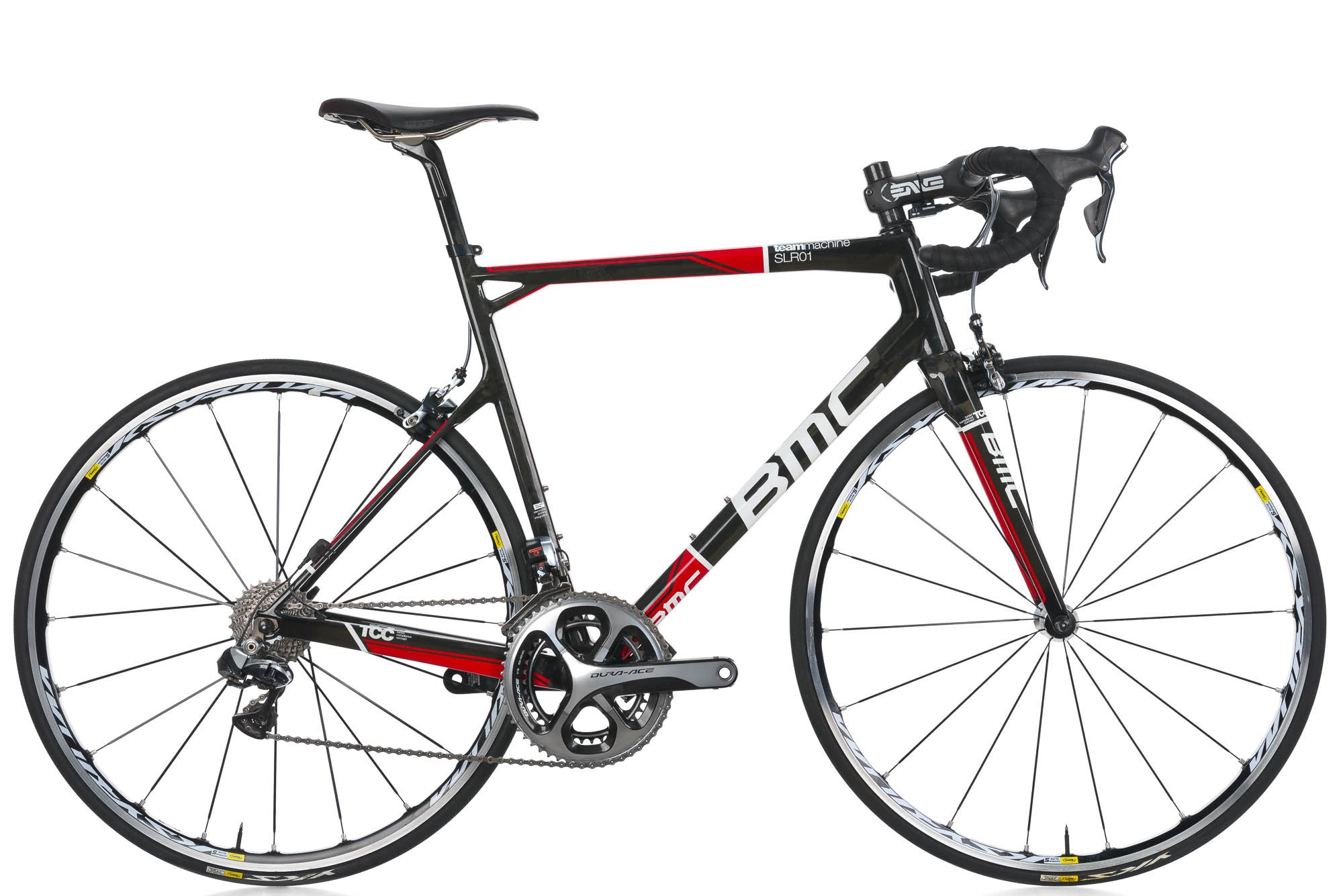 You could argue that the BMC Timemachine TT01 is the bike that actually won the Tour. Evans used the Swiss brand’s new TT bike to deal the finishing blow to Schleck in the final time trial. But the Teammachine SLR01 road bike that Evans rode day in, and day out is what laid the foundation for victory.
You could argue that the BMC Timemachine TT01 is the bike that actually won the Tour. Evans used the Swiss brand’s new TT bike to deal the finishing blow to Schleck in the final time trial. But the Teammachine SLR01 road bike that Evans rode day in, and day out is what laid the foundation for victory.
The Teammachine features dropped seat stays, and BMC was one of the earliest brands to embrace this design, which improves compliance. It has since caught on across the industry as more manufacturers place a greater emphasis on rider comfort.
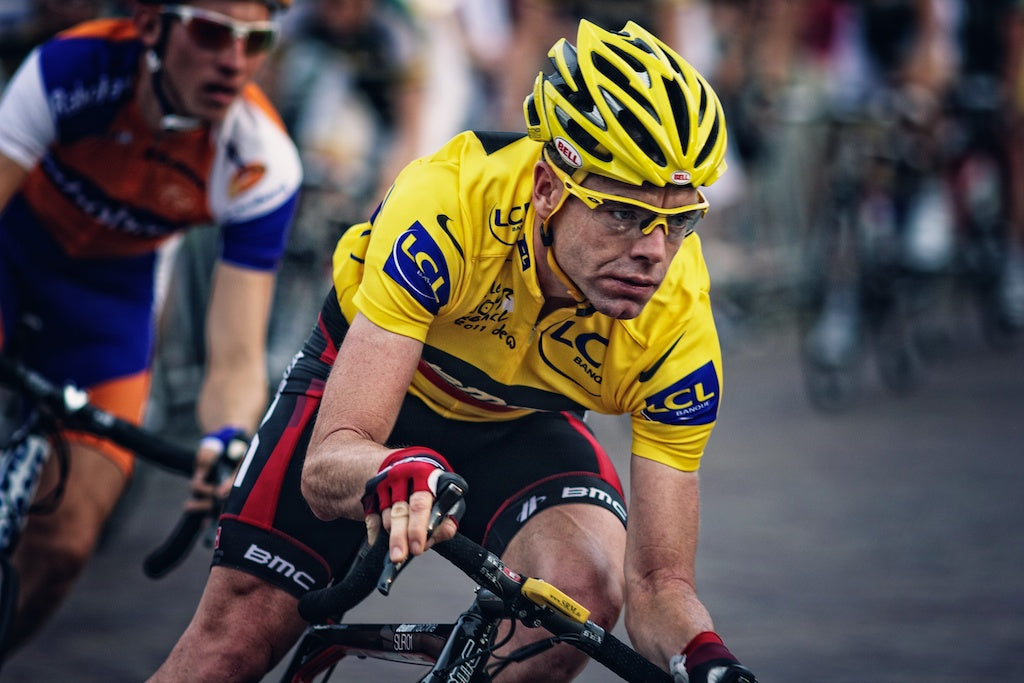 Cadel Evans shows off the yellow jersey and the Teammachine in a post-Tour crit. Photo by: Michiel Jelijs | Flickr Creative Commons
Cadel Evans shows off the yellow jersey and the Teammachine in a post-Tour crit. Photo by: Michiel Jelijs | Flickr Creative Commons
Many of Evans’s teammates in 2011 chose to ride the more aerodynamic Timemachine Road TMR01, but as a GC contender, Evans needed a lighter bike for climbing. Fortunately, BMC had just revamped the Teammachine for 2011 and shaved 100g off the frameset.
To save a little more weight, Evans rode a 51cm bike which is small for his height (5’8”). The Teammachine already has a very aggressive low stack height, and sizing down only makes the saddle to bar drop even more severe. One other odd detail: Evans liked to chop two centimeters off the end of his handlebars to get his fit perfect.
Evans's drivetrain choice was also cutting edge — Shimano Dura-Ace Di2. Di2 was released two years prior, but many pros were hesitant to go electronic, fearing reliability issues. Evans had no such concerns and suffered no Di2-related mechanicals. Now, electronic drivetrains are standard across the pro peloton.
3. The rise of the Sky bots
Bradley Wiggins becomes the first British Tour de France winner - 2012
Though overshadowed in later years by his former domestique, Chris Froome, Bradley Wiggins still has the distinction of being the first Brit to win the Tour.
This decade will be remembered as the time of Team Sky. With a massive budget, a performance philosophy centered around “marginal gains,” and a legion of world-class riders, it won seven out of the last 10 editions of the Tour (and counting). It’s become a common sight to see a mob of Sky (now Ineos) jerseys controlling the front of major bike races.
In fact, in 2012 Wiggins’s biggest challenger was his teammate Froome. Team Sky went so far as to hold Froome back on the major climbs so Wiggins could ride to Paris in yellow.
The bike: 2012 Pinarello Dogma 65.1 Think2
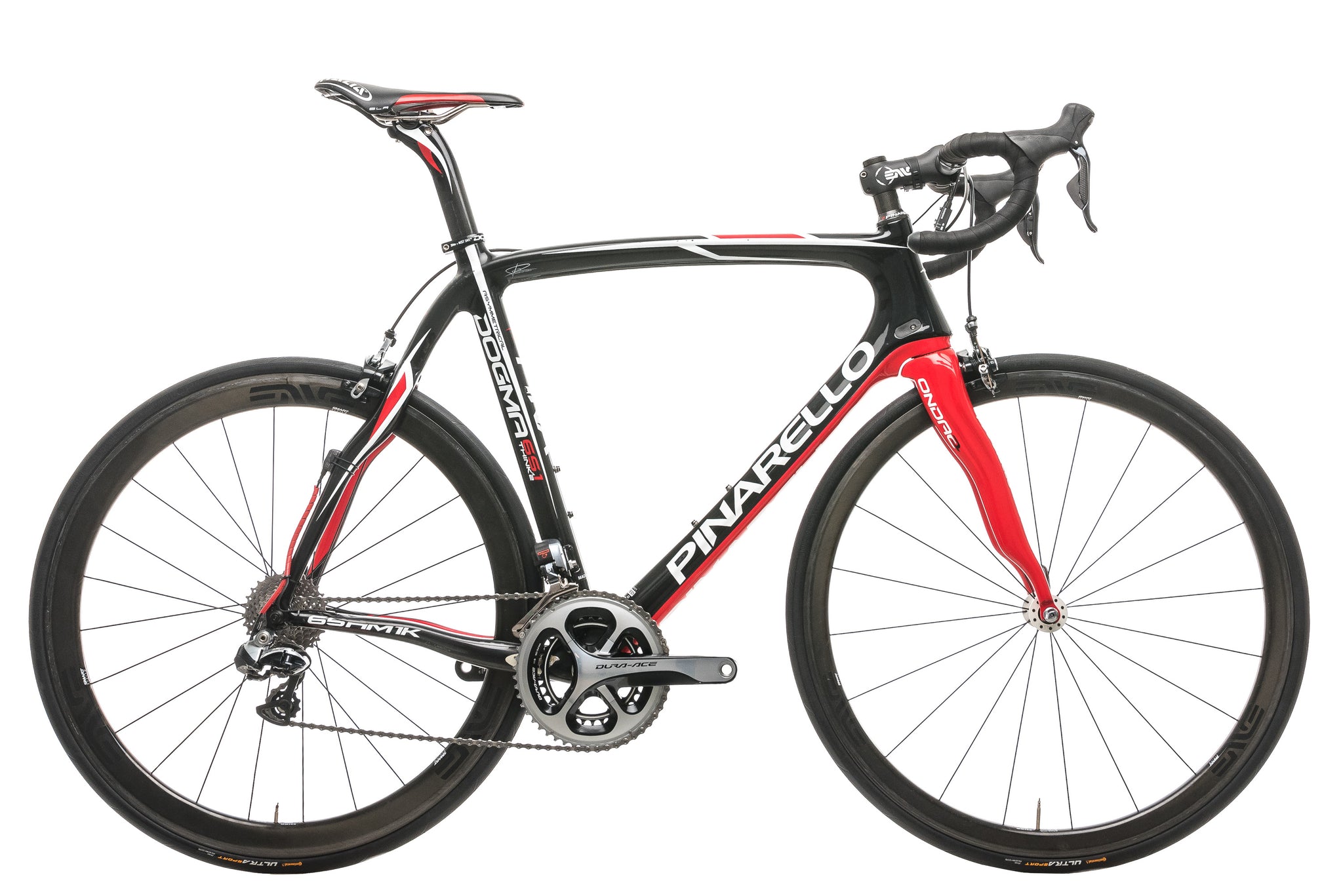 At the time, the Pinarello Dogma 65.1 was one of the most expensive framesets on the market at nearly $5,000. Though some Pinarello models are manufactured in China, each carbon Dogma 65.1 frame was handmade in Treviso, Italy.
At the time, the Pinarello Dogma 65.1 was one of the most expensive framesets on the market at nearly $5,000. Though some Pinarello models are manufactured in China, each carbon Dogma 65.1 frame was handmade in Treviso, Italy.
The Pinarello Dogma stood out thanks to Pinarello’s “ONDA” design. Onda means “wave” in Italian, and the Dogma uses asymmetric wavy fork legs and rear stays. Some loved the bold and unique look. Others thought it was strange and alien. Many found the ride to be punishingly stiff. It is a race bike after all.
Pinarello began experimenting with wavy carbon forks the decade prior. They reportedly were popular with Pinarello’s pro riders like Erik Zabel because they had more rigidity for cornering, especially on fast descents. The asymmetric design was said to balance the unequal strain from pedaling forces on the rear end, caused by having the drivetrain on one side.
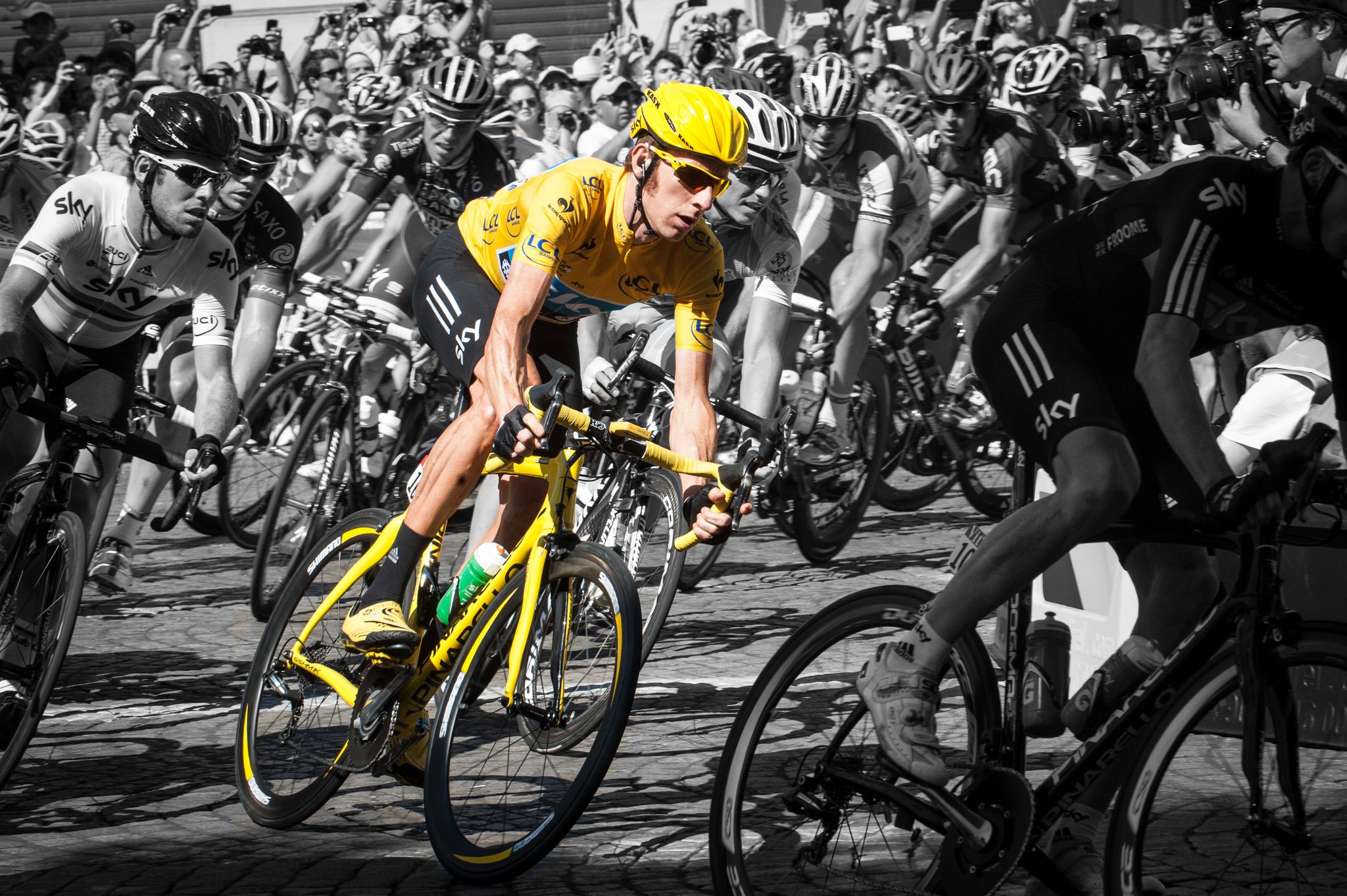 Bradley Wiggins and the Dogma 65.1 Think2 in yellow. Photo by: Josh Hallett | Flickr Creative Commons
Bradley Wiggins and the Dogma 65.1 Think2 in yellow. Photo by: Josh Hallett | Flickr Creative Commons
In the 2012 Tour, the Dogma 65.1 was not only the overall winner, but it was also the winningest bike of the Tour. Sky’s sprinter, Mark Cavendish, won three stages, Chris Froome took a mountaintop win on stage 7, and Movistar’s Alejandro Valverde also took a win aboard a Dogma on stage 17.
In the search for maximum weight savings, Team Sky mechanics supposedly weighed all the ball bearings to be installed and only chose the lightest ones. A tiny difference, but in the science of "marginal gains" it all adds up.
Notably, the Dogma came in a whopping 12 different sizes (most brands offer five or six sizes). Medium sizes were offered in one-centimeter increments. For riders seeking the perfect fit, dropping the coin for a Pinarello is often worth it.
4. The Tourminator
Peter Sagan's explosive Tour de France debut - 2012
In 2012, Tour fans were introduced to the phenom that is Peter Sagan. He won the opening road stage and then won two more stages against established sprinters like Andre Griepel and Matthew Goss. By the end, he’d won the points classification's green jersey. Most impressive of all, he was only 22 years old and riding his first Tour de France.
When Sagan won, his celebrations were unlike any others — Forrest Gump impersonations, the chicken dance, and more. The 2012 Tour was just a preview of the amazing wins and goofy antics we’d enjoy over the coming years. After seven green jerseys, three consecutive world championship wins, and 100+ other major victories, Sagan has proven he is the best all-around rider of the decade.
The bike: 2012 Cannondale SuperSix Evo Hi-Mod
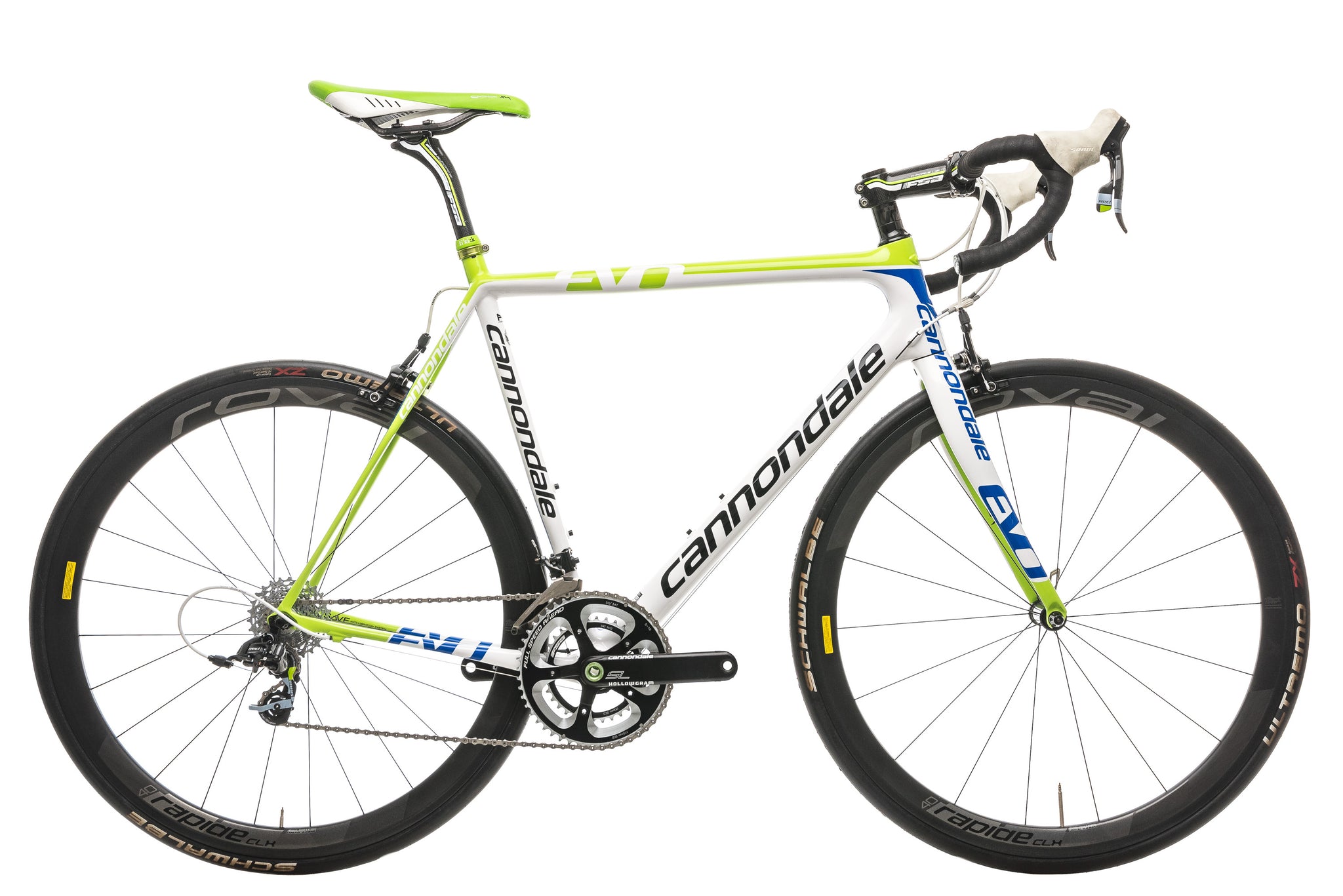 Sagan made his Tour debut with the Liquigas-Cannondale team and rode the venerable Cannondale SuperSix Evo. Sagan made such a splash that Cannondale gifted him a custom “Tourminator” bike painted with Sagan’s favorite hero, the Terminator. In later years, Sagan had so much influence he was able to get a SuperSix Evo with custom geometry. It was essentially a 56cm bike with a 58cm top tube to suit his preference for a longer bike with lower stack and standover.
Sagan made his Tour debut with the Liquigas-Cannondale team and rode the venerable Cannondale SuperSix Evo. Sagan made such a splash that Cannondale gifted him a custom “Tourminator” bike painted with Sagan’s favorite hero, the Terminator. In later years, Sagan had so much influence he was able to get a SuperSix Evo with custom geometry. It was essentially a 56cm bike with a 58cm top tube to suit his preference for a longer bike with lower stack and standover.
This generation of SuperSix was also one of the lightest production road frames at 695 grams. The weight savings were achieved through Cannondale’s new carbon molding technique. Carbon fiber material was laid around an EPS core (similar to the foam in helmets). This core allowed an extremely precise assembly and carbon layup that maximized weight savings by reducing excess material. When paired with an ultra-light SRAM Red drivetrain, it meant Liquigas-Cannondale had to add a significant amount of ballast to meet the UCI minimum weight requirement.
 Peter Sagan looks down at his trusty SuperSix Evo. Photo by: jvanattenhoven | Flickr Creative Commons
Peter Sagan looks down at his trusty SuperSix Evo. Photo by: jvanattenhoven | Flickr Creative Commons
While other companies were experimenting with airfoil tube shapes, sloping top tubes, and dropped seat stays, Cannondale stuck to classic bike design. The tubes were mostly round and the frame used a level top tube. For bike aficionados, it was one of the few carbon bikes that had a classic profile.
Despite the tube shape, Cannondale claimed that the SuperSix Evo still had excellent aerodynamic properties, especially in crosswinds, thanks to subtle tube-shaping. Clearly, Sagan had no problem launching into the wind and out-sprinting the world’s best so maybe Cannondale was onto something. Unfortunately, for the lovers of this classic design, Cannondale has fallen in line with the rest of the industry and produced the latest SuperSix with truncated airfoils and dropped seat stays.
5. Froome's footrace
Chris Froome is forced to run up Ventoux - 2016
Yes, Team Sky again. The most dominant team accounts for a good number of the Tour’s greatest moments in recent history. But this one needs to be included not because it’s a special victory, but because it’s one of the strangest and most memorable yellow jersey moments ever.
Chris Froome and Baulke Mollema were chasing Froome’s former teammate, Richie Porte, up Mount Ventoux. The camera motorcycle in front of the riders suddenly stopped and the riders all crashed into the back of the stalled motorcycle.
Mollema remounted and continued, but Froome’s bike was broken. In the panic, he started running. The image of Froome frantically trotting uphill in his cycling shoes will stick with fans forever. The Team Sky car was blocked in the chaos so Froome took a spare bike from the Mavic neutral service car but it had the wrong pedals, and it was the wrong size. Eventually, he got a team bike and raced to the line, losing almost two minutes. Fortunately, the jury was kind to Froome and Porte, giving them the same finishing time as Mollema.
The bike: 2016 Pinarello Dogma F8
 The Dogma F8 was a major design departure from the Dogma 65.1. Gone were the distinctive wavy fork legs and rear stays. They were replaced with a more understated curved shape. To some, this was a tragedy. To others, it was a relief. There were three major design goals for the new Dogma F8: improve comfort, reduce weight, and achieve better aerodynamics.
The Dogma F8 was a major design departure from the Dogma 65.1. Gone were the distinctive wavy fork legs and rear stays. They were replaced with a more understated curved shape. To some, this was a tragedy. To others, it was a relief. There were three major design goals for the new Dogma F8: improve comfort, reduce weight, and achieve better aerodynamics.
For the aero side of things, Pinarello partnered with Jaguar, one of Team Sky’s Sponsors, for extensive wind tunnel testing. The first finished Dogma F8 first appeared beneath Froome and his Sky teammates just before the 2014 Tour de France. Froome crashed out of the race so it wouldn’t win the Tour until 2015.
The down tube, seat tube, seat stays, and seatpost all feature Pinarello’s “Flat Back” shaping, which is essentially another name for the popular truncated airfoil design (you may be familiar with Trek’s Kammtail or Scott’s FO1 designs). The wavy fork legs and stays were ditched to optimize their aero shape, but they retained Pinarello’s asymmetric design (the drive side is thicker than the non-drive side) to balance out pedaling forces and increase lateral stiffness.
 Despite the incident, Chris Froome kept yellow on the Dogma F8. Photo by: Filip Bossyut | Flickr Creative Commons
Despite the incident, Chris Froome kept yellow on the Dogma F8. Photo by: Filip Bossyut | Flickr Creative Commons
With the redesign, the Dogma F8 claimed to be nine percent lighter and 28 percent stiffer than the previous Dogma 65.1. But the massively improved comfort was the most noticeable difference. The F8 became a bike that regular riders with soft backsides could ride for hours without complaint.
Otherwise, the geometry for the Dogma F8 is exactly the same as the Dogma 65.1, and the huge range of sizes remained. The exorbitant $5,000 price tag (for the frame only) also didn’t change.
6. Dutch duel
Annemeik van Vleuten's La course victory - 2018
The Tour de France organizers introduced La Course in 2014, a one-day women's race that is loosely affiliated with the men's event. Hopefully, in the future, the women will get a longer race that’s truly comparable to the Tour, but this is what we have for now. For the first three years, the race was held on the Champs-Élysées, a flat course for sprinters. Fortunately, they went into the mountains for 2017 and 2018 and it resulted in far more exciting racing.
Annemeik van Vleuten is one of the best female racers of the decade with big wins at the Giro Rosa and road world championships. Her 2018 ride at La Course ended in a nail-biting sprint. She and fellow Dutch rider, Anna van der Breggen, separated themselves on the Col de la Colombière. At the summit, van der Breggen had gained three seconds on van Vleuten and the pair raced down the descent. Within sight of the finish, van Vleuten pounced on the exhausted van der Breggen, and managed to snatch victory in the final 20 meters.
The bike: 2018 Scott Foil RC
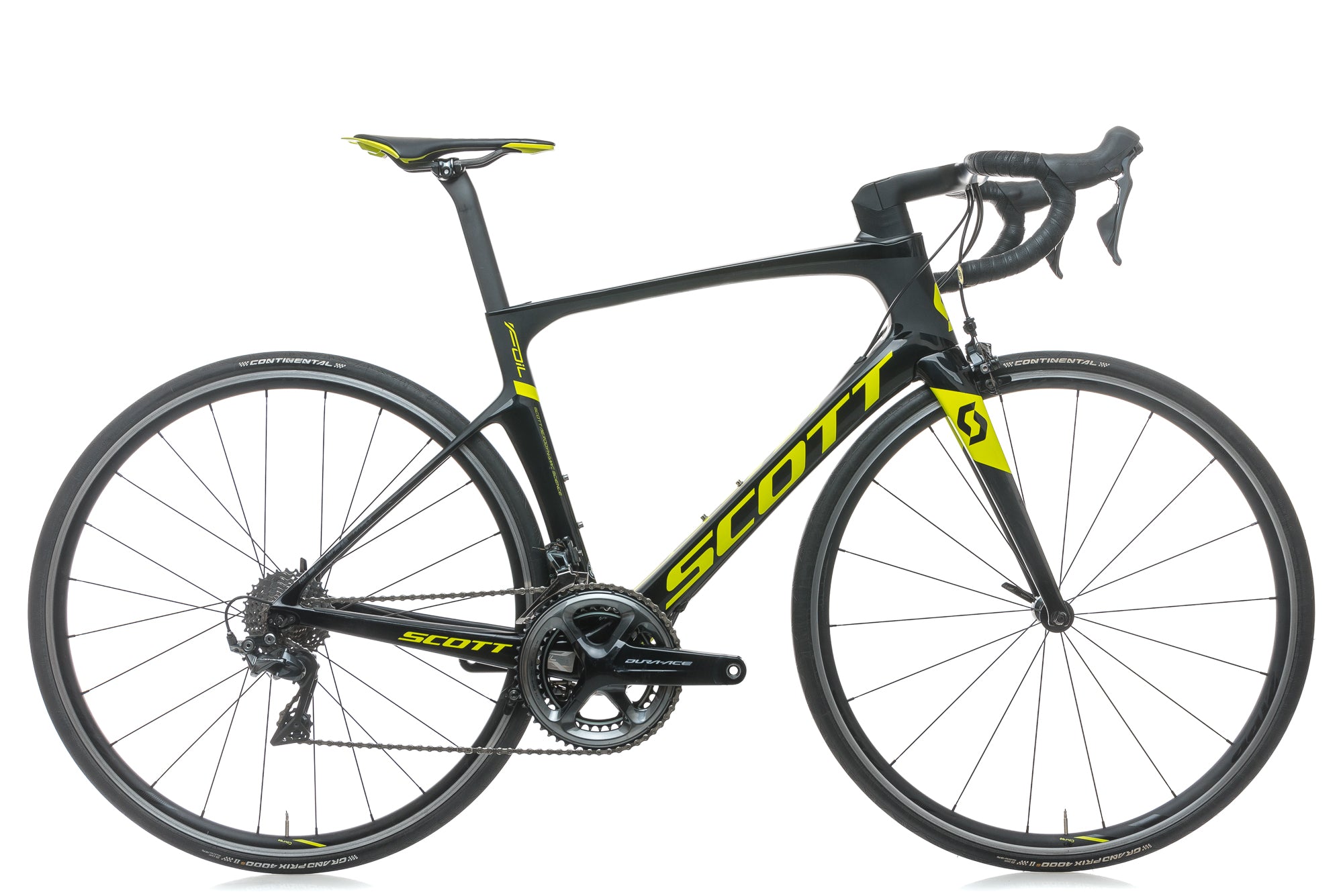 Scott introduced the first “Project FO1” bike in 2010. This bike would later become the Scott Foil and the "FO1" is the origin of the Foil name. The design combined the best attributes of Addict road and Plasma 3 time trial bikes, to create an aero weapon. The Project F01 weighed just five percent more than an Addict, retained the same stiffness, and reduced frame drag by 20-30 percent. Mark Cavendish has proven the effectiveness of this design with multiple sprint stage wins at Tour de France.
Scott introduced the first “Project FO1” bike in 2010. This bike would later become the Scott Foil and the "FO1" is the origin of the Foil name. The design combined the best attributes of Addict road and Plasma 3 time trial bikes, to create an aero weapon. The Project F01 weighed just five percent more than an Addict, retained the same stiffness, and reduced frame drag by 20-30 percent. Mark Cavendish has proven the effectiveness of this design with multiple sprint stage wins at Tour de France.
Scott was one of the first brands to adopt large volume, truncated aero tubes. Rather than use conventional airfoil profiles, it employed a truncated teardrop shape with a 3:2 aspect ratio. This balanced stiffness, weight, and aerodynamics. It was similar to Trek’s Kammtail concept, but Scott removed more trailing edge material and used a more rounded “cut line” on each tube. Scott claimed the less aggressive shape reduced drag numbers at higher yaw angles and had better ride quality.
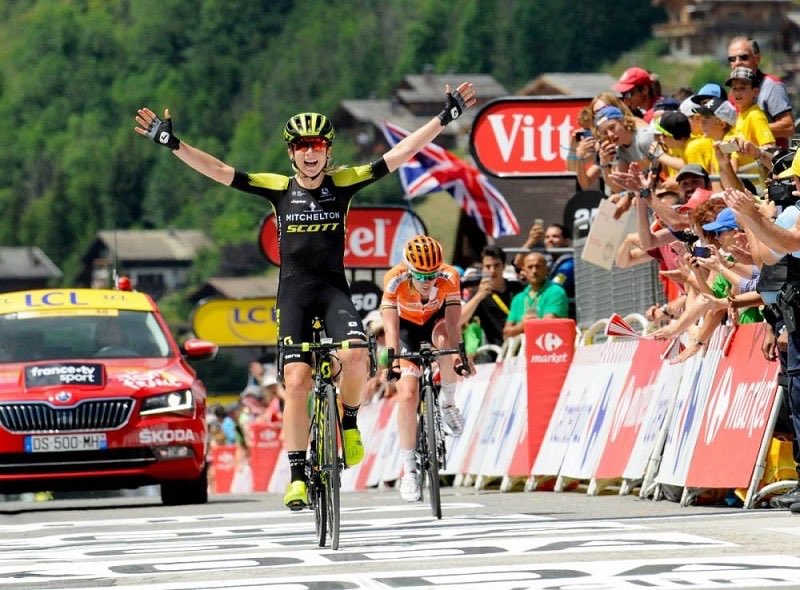 Annemeik van Vleuten victorious on the Scott Foil. Photo by: Roland Tissier | Flickr Creative Commons
Annemeik van Vleuten victorious on the Scott Foil. Photo by: Roland Tissier | Flickr Creative Commons
Like many new aero road bikes, the Foil also uses an integrated aero stem. These are always a huge pain to set-up, although Shimano’s Dura-Ace Di2 drivetrains reduce some of the cable routing headaches.
In 2018, Scott introduced disc brake versions of the Foil and Addict road bikes. But in true roadie fashion, most pros were slow to adapt. Van Vleuten and the rest of her Mitchelton-Scott team chose to ride the more traditional rim-brake Foil for La Course.
7. 'Cross-over success
Cyclocross champ Wout van Aert’s first Tour de France win - 2019
This is my personal pick. There was so much drama in the 2019 Tour — Thibaut Pinot abandoning with a torn muscle; Julian Alaphillipe losing yellow on a shortened stage due to a mudslide and hailstorm; Egan Bernal becoming the youngest Tour winner. But forget all that.
Van Aert is one of my all-time favorite riders, which made stage 10’s sprint finish the most exciting finish of 2019 for me. I’ve followed van Aert since his early cyclocross days and I felt like a proud father seeing my boy finally make it big. The joy wouldn’t last though. A favorite to win the Stage 13 time trial, van Aert clipped a barrier and suffered a season-ending crash.
Since then he’s recovered and has shown that, along with longtime rival, Mathieu van der Poel, he is one of the best riders of the new generation. As of 2021 he's won 3 more Tour stages and shown he can time trial well, sprint with the fastest sprinters, and climb with the best climbers. He'll be lighting up the Tour for years to come!
The bike: 2019 Bianchi Oltre XR4
 A disc version of the Oltre XR4. Wout van Aert, however, rode the rim brake version.
A disc version of the Oltre XR4. Wout van Aert, however, rode the rim brake version.
Bianchi has been making bikes since 1885, the world’s oldest bike manufacturer. The Oltre XR4 is painted in Bianchi’s signature celeste color. There are many stories about the color’s origin. Some say Edoardo Bianchi was so captivated by the eyes of Regina Margherita of the Savoia Royal House that he tried to reproduce their color on a bike he gifted to her. Or maybe it was made to mimic the beautiful skies of Milan. Or perhaps it’s the result of mixing together surplus military paint. Whatever the truth is, it is cycling’s most iconic color.
Wout van Aert’s 2019-2020 road victories have been achieved on the Oltre XR4, suggesting that Bianchi’s flagship bike, which hasn’t seen a major update since its release in 2016, can still hack it with the latest and greatest. The typical life cycle of a high-end road race bike is around three-to-four years, so maybe we’ll see a new Oltre XR next year.
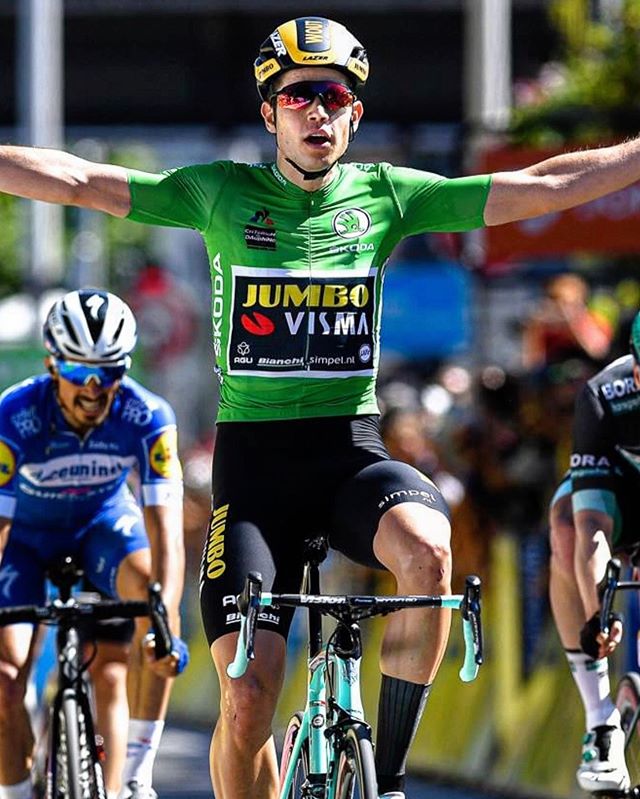 Wout van Aert winning stage 10 on the Oltre XR4. Photo by: Glory Cycles | Flickr Creative Commons
Wout van Aert winning stage 10 on the Oltre XR4. Photo by: Glory Cycles | Flickr Creative Commons
Since 2018, the Oltre XR4 has been available with disc brakes, but van Aert and his Jumbo-Visma teammates stuck to the rim brake model.
For the XR4, Bianchi revamped the XR2 frame using computational fluid dynamics and flow visualization for aerodynamics. The seat stays are positioned wide of the rear wheel to help reduce drag, and this has the added benefit of giving more tire clearance.
The Oltre XR4 uses “Countervail" technology, a feature that has been used on other, more comfort-focused bikes in Bianchi's range. It was originally developed for the US military and NASA (bike companies love saying their stuff is aerospace-grade) and it’s a composite-material system that combines viscoelastic carbon material within a unique fiber preform to cancel out road vibrations.
Bianchi’s reasoning is that your body is the biggest contributor to aerodynamic drag when you’re riding, so anything that keeps you comfortable enough to stay in a low, aero position is going to benefit your overall speed more than an aero frame or wheels.
Vintage bonus: Eight seconds
The closest finish in history. Greg LeMond’s vs. Lauren Fignont - 1989
Greg LeMond’s 1989 Tour win is a year older than Tour legend Peter Sagan and five years older than rising star, Wout van Aert. (Do you feel old yet? It might be time to buy a mid-life crisis road bike!)
From 1986 to 1989, LeMond went from Tour winner to gunshot victim. Many questioned if he would ever return the same caliber of rider after his hunting accident. Coming into the final stage of the 1989 Tour, LeMond was riding well, but trailed French rider Laurent Fignon by 50 seconds. The traditional sprint finish on the Champs-Élysées was replaced with an individual time trial, but he was not expected to be able to make up the deficit.
Lemond had a plan though. He put a set of triathlon-style aero bars on his bike, and an aero helmet on his head. His critics called these devices ugly, unnecessary, dangerous, and even maybe illegal. But LeMond had nothing to lose. They’ve since become standard equipment for time trialing.
LeMond won the stage, but more importantly, Fignon finished 58 seconds slower, costing him the victory. LeMond won his second Tour title by only eight seconds — the smallest winning margin in history. It is still the most exciting and dramatic Tour finish ever.
Bike: 1989 Bottecchia TT Bike
 Greg LeMond’s steel-framed Bottecchia was similar to most other time trial bikes in the 1989 Tour de France. It was set-up as a “funny bike” with a 650b front wheel and Mavic rear disc wheel. Funny bikes earned their name because their aggressive, raked stance drew comparisons to American funny car dragsters.
Greg LeMond’s steel-framed Bottecchia was similar to most other time trial bikes in the 1989 Tour de France. It was set-up as a “funny bike” with a 650b front wheel and Mavic rear disc wheel. Funny bikes earned their name because their aggressive, raked stance drew comparisons to American funny car dragsters.
Funny bike designs emerged in 1984 with Francesco Moser’s hour record bike. The reduction in height at the front (typically achieved with a 24” or 650c front wheel) was intended to reduce aerodynamic drag. The rear generally kept the standard 700c size as it had less rolling resistance and didn’t require oddly large chainring tooth counts to obtain the desired gear ratios. Eventually, the UCI outlawed such designs in 1996.

Greg LeMond making use of his aero bars. Photo courtesy of Mavic.
LeMond’s bike was equipped with a massive 55x12t top gear, which he used to achieve an average speed of 54.545 km/h (34.52 mph). At the time, this was the fastest time trial ever ridden in the Tour de France.
What really set LeMond’s Bottecchia apart was the addition of the Boone Lennon-designed Scott clip-on aero bars. His victory ushered in a new era of time trialing, where aerodynamics are as important as strength and skill. It started a technological arms race that’s still being fought today as companies make each new bike slightly more aero than the last.
What do you think? Did we miss any of your favorite Tour de France moments or bikes? Let us know what you think in the comments!

